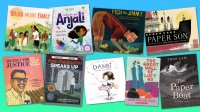Incorporating Asian American and Pacific Islander Experiences in the Early Grades
These books help students explore historical and contemporary experiences of Asian American and Pacific Islander communities.
Your content has been saved!
Go to My Saved Content.Asian American and Pacific Islander (AAPI) communities have a long history in the United States, from Filipino sailors arriving as early as the 1750s to the present day, with AAPIs who have origins in more than 30 countries and number 22 million, nearly 6 percent of the U.S. population. Despite this growing presence, there remains a gap in curricula regarding AAPI communities and their experiences in our schools.
Children’s literature offers one way to close this gap. Multicultural education experts, including Emily Style and Rudine Sims Bishop, developed the idea of children’s literature serving as “windows” into others’ realities and “mirrors” for children from backgrounds that have been historically excluded to see themselves and their families reflected in texts.
In research I’ve done with colleagues, we developed another category to add: the prism. A prism refracts a beam of light into various colors that go in different directions. Similarly, a text that serves as a prism allows for multiple conversations and critical engagements. While windows and mirrors offer opportunities for exploring and reflecting on cultural traditions, holidays, foods, and ways of life that are all extremely important, the prism, when applied to children’s literature, presents the chance to critically analyze inequalities and injustices in age-appropriate ways.
While children’s literature is a powerful way to center the experiences of marginalized communities in the classroom and present the many positive contributions these communities have made, reading a book is just one part of the lesson. Proper introduction of a text, followed by adequate unpacking of the themes and the questions they raise, is essential for engaging in conversations that can lay the foundation for further critical inquiry.
The following books offer windows (mirrors for some students) and prisms to discuss and analyze the historic and contemporary experiences of Asian American and Pacific Islander communities at the preschool and elementary school level. Where available, there are hyperlinks to lesson plans that offer educators ideas for using the book in their classrooms, along with sample questions for discussion during and after reading.
Books for Grades Pre-K to 2
Ohana Means Family (educator guide), written by Ilima Loomis and illustrated by Kenard Pak, tells the story of a Hawaiian luau through a rhyming poem about family and land. Centering on the story of one family and its cultural traditions, this book opens up discussions about the diverse traditions of students and their families at the early elementary school level.
Always Anjali (educator/parent guide), written by Sheetal Sheth and illustrated by Jessica Blank, features a young girl named Anjali, who, after being teased about her name, decides to change it to Angie. Through the help of friends and discussions with her family, she finds pride in her name and ways to deal with those who have been bullying her.
Fish for Jimmy (educator guide), written and illustrated by Katie Yamasaki, tells the story of a family in a Japanese internment camp in the United States during World War II. Taro’s younger brother Jimmy isn’t eating and is getting weak, so Taro sneaks out of the camp one night to find fish (Jimmy’s favorite food) for him.
Danbi Leads the School Parade (educator guide), written and illustrated by Anna Kim, is a touching story of a cultural encounter when a young girl from Korea first comes to a U.S. classroom. Unfamiliar with the games and foods of her American peers, Danbi finds her own way to connect across language and cultural barriers.
Paper Son: The Inspiring Story of Tyrus Wong, Immigrant and Artist (educator guide), written by Julie Leung and illustrated by Chris Sasaki, tells the true story of a young immigrant from China in the early 1900s who faces limited opportunities, given restrictive immigration laws and discrimination, and later becomes a well-known artist.
Books for Grades 3 to 6
The Paper Boat: A Refugee Story (educator guide), illustrated by Thao Lam, has no words—it’s a series of powerful images about a family leaving Vietnam for the United States as refugees during the Vietnam War. The family’s story intersects with the story of a group of ants who also play a central role in the book.
Journey for Justice: The Life of Larry Itliong (educator guide), written by Dawn Bohulano Mabalon and Gayle Romasanta and illustrated by Andre Sibayan, tells the story of Larry Itliong, a farmworker and labor activist who, along with Cesar Chavez and Dolores Huerta, cofounded the United Farm Workers.
Fred Korematsu Speaks Up (educator guide), written by Laura Atkins and Stan Yogi and illustrated by Yutaka Houlette, tells the story of Fred Korematsu, who was jailed for resisting Japanese internment during World War II. He took his case to the highest courts, fighting for justice for decades.
The Great Wall of Lucy Wu (educator guide), by Wendy Wan-Long Shang, is a story about a young Chinese American girl whose aunt comes from China to live with the family. The story discusses themes of identity, family, and culture.
Through these books, and many others that offer a glimpse into distinct realities, educators can humanize and center AAPI communities whose stories have long been neglected in curricula. When our classrooms and schools reflect our rich diversity, we can ultimately foster greater empathy and respect in our society.
